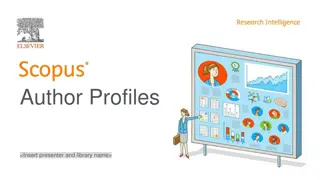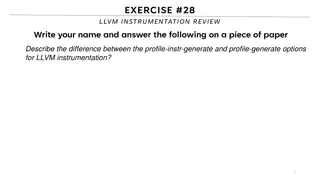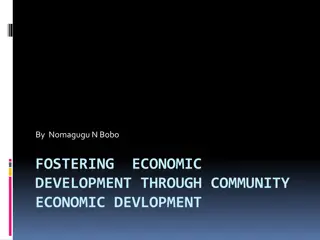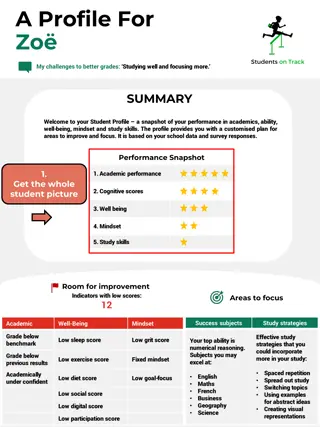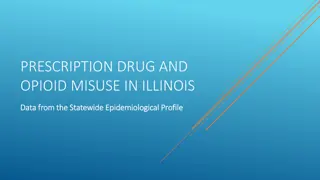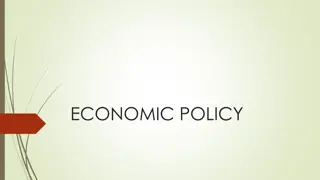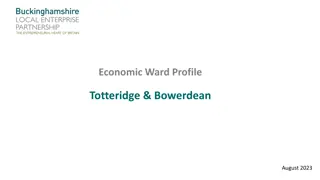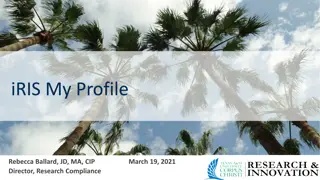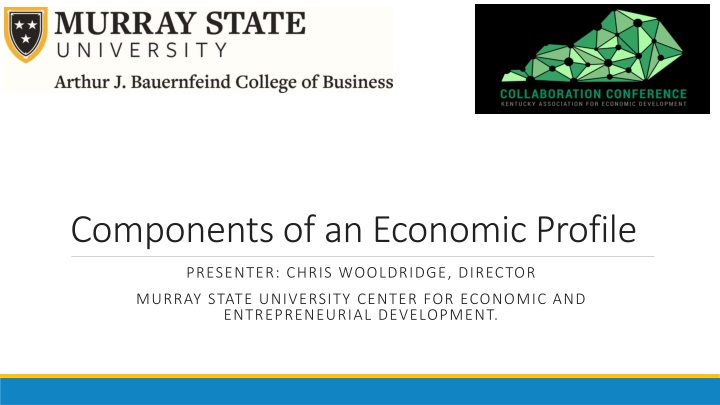
Components of an Economic Profile Overview
In this session, the basic structure of an economic profile is explored, emphasizing its importance for economic developers to comprehend the local economy. Creating a comprehensive economic profile enables a deeper understanding of community strengths and weaknesses, aiding in strategic decision-making for economic development initiatives. The session delves into the significance of economic profiles, particularly in the context of community expansion, recruitment, and retention efforts. Students are challenged to complete a profile project within a tight timeframe, utilizing incomplete information to present findings effectively.
Download Presentation

Please find below an Image/Link to download the presentation.
The content on the website is provided AS IS for your information and personal use only. It may not be sold, licensed, or shared on other websites without obtaining consent from the author. If you encounter any issues during the download, it is possible that the publisher has removed the file from their server.
You are allowed to download the files provided on this website for personal or commercial use, subject to the condition that they are used lawfully. All files are the property of their respective owners.
The content on the website is provided AS IS for your information and personal use only. It may not be sold, licensed, or shared on other websites without obtaining consent from the author.
E N D
Presentation Transcript
Components of an Economic Profile PRESENTER: CHRIS WOOLDRIDGE, DIRECTOR MURRAY STATE UNIVERSITY CENTER FOR ECONOMIC AND ENTREPRENEURIAL DEVELOPMENT.
Session Introduction: This session in an overview of the basic structure of an economic profile. The economic developers success depends in large part on understanding the local economy and economic conditions. Creating a comprehensive descriptive economic profile of the allows the economic development professional to better understand the strengths and weaknesses of the community.
Why a Profile? Profile: A profile is a narrative that covers multiple components of the community from an economic development perspective. The narrative is supported by data presented in various methods. Why have one? To understand the current state of the community To understand what work needs to be done To understand what expansion, recruitment and retaining efforts are likely to be most successful. It prepares you for RFI s. Lack of detail / Incomplete Responses = thinning the herd. Labor / work force is the biggest economic development sale. It helps you build your story. Building up your community profile. Everything has changed due to the CV19.
The Class Challenge As part of the master program in economic development, one of projects the students must complete is the profile. The scenario is that the student has been recently hired and on the first day the chairman of board advises the new EDC president that board would like a presentation addressing the current state of the community from and economic development perspective at the next board meeting which is in 30 days. The student is assigned this project with 30 days complete it and produce a report addressing the components of the profile. They must learn to work with a tight time line, imperfect and incomplete information and defend the report with references. Not unlike what all EDP do in real life .
Economic Profile Outline Demographics Research Base Quality of Life Higher Education Resources Income and Wages Transportation Labor Force Characteristics Utilities Business Establishments Taxes International Linkages Land and Building availability Environmental Regulations
Demographics A community s demographic characteristics reveals whether the community is small or larger, declining or growing and if the population is homogenous or diverse. Also if the community has an equal distribution of age groups or is more concentrated toward a younger work force or an older workforce. Cohorts of ages moving over time through a community toward retirement has ED implications especially in seeking replacement workers. Also measured is mobility and are younger workers finding employment or are leaving to find employment. Population by age Population by ethnicity Households Net migration Workforce Education Attainment
Data Resources Census Bureau Decennial Survey American Community Survey Local/Regional Agency
Quality of Life The component seeks to measure the aspects of the community that will draw firms and, more importantly, employees for the firm. The higher the pay scales of the employees, the higher the importance of QOL as higher pay allows for discretionary spending for restaurants, entertainment and higher end durable goods and luxury services. Safe environments increasingly are part of the QOL determination. A community with a unique environment appeals to younger professionals and supports the firms hiring efforts. QOL is beginning to be a given. Now the challenge is becoming the differentiation the story. Every community has a story and it must be told. Climate Housing Supply and Prices Workforce housing supply
Quality of Life Education Spending per student Student Teacher ratios Achievement test results High School graduation rates Vocational and University attendance/graduation Health Care Crime Rate Culture Museums, Art, Sports and events Green Space and recreational outlets
Data Resources National Climate Data Center Census Bureau National / Local Realtors associations State department of education or public institutions Local School District University Systems FBI Uniform Crime reports Local business, medical associations Chamber of commerce's Visitors and Tourism Bureaus
Income and Wages This component is important in understanding the current standard of living. Sources of income wages, investment or transfer payments. As economic professional seek to create goods job (fulltime, heath care benefits, retirement benefits, advancement) one must know the current levels to build from. This component helps one understand the level of working poor as an example Median earnings Income levels Distribution by quintile Working poor Proportion of jobs with health care and retirement benefits
Data Resources Bureau of Labor statistics (National and regional offices) State Employment / Labor departments Census Bureau
Labor Force Characteristics Of all components, this one represent the more important to the community. Job creation provides the earnings from employment as the primary source of income for individuals. This income allows for families to support themselves and define the stand of living. The characteristics of the labor force of the community are vital for determining the future of the community. Strengthening the labor force is an important economic development goal. Civilian Labor Force: Labor force Participation Rate Unemployment Rate
Labor Force Characteristics Industry: Good Producing: Natural Resources, mining, construction, manufacturing. Service Providing: Trade, Transportation, utilities, information, financial service, professional and business, education, healthcare, leisure, hospitality, other, public administration. Occupation: Management, business and financial, computer, Architecture, engineering, social services, legal, education, arts / entertainment, sports, media, health care, tech, food, etc.
Data Resources Bureau of Labor Statistics Census Bureau State Employment / Labor department County Business patterns Economic Census Annual Survey of Manufactures
Business Establishments by Industry Sector and Employment Size Understanding the different business sectors operating in the community help identify the sectors on which the EDP can build upon in recruitment and retention efforts. Concentration of industry establishments can indicate a cluster which can be developed further and firm that have headquarter operations in the community are more likely to be permanent to the community than branches, subsidiaries or processing offices. Also, what research and development effort within firms may produce innovations and possible spur additional firm creation? By industry, function (headquarters, back office, branch, R & D) New to the area / Long time to the area Expansion / New facilities Downsizing / closing / layoffs
Data Resources Statistics of US Businesses Local business journals (The Lane Report) Local and State industrial agencies Local surveys
International Linkages This component seeks to identify to what extent locally produced products and services are sold on the global market. Also, what global industries are currently located in the community on which relationships and further development could be pursued. Foreign Owned Companies US Companies with foreign branches Foreign bank branches US banks with international departments Foreign consulates Import/Export bookers International Education Programs
Data Resources USA Trade on line Industry Trade Associations University Research Offices
Research Base Research activity and capability can provide the opportunity for innovation of product or services. This can lead to commercialization and the development of new clusters. Research can be a draw form higher paid professional / skilled labor, more expensive equipment and support services. Corporate Non profit University Government Military
Data Resources US Patent and Trademark Office Trade Associations University Research offices
Higher Education Resources Support for business and industry can be derived from higher education sources from training works forces, assisting in testing, providing research and data gathering University Centers, schools SCORE, SBDC Community Colleges Labs
Data Resources State / Regional University Community College System
Transportation Transportation data should reflect how connected communities are with other communities, markets and economic centers. How timely and cost effectively can people get the jobs and products can be moved. The more divers the modes of transportation are into and out of a economic center, the more appealing a community will be to certain industry's. Interstate / Parkways / Turnpikes - Drive times for labor sheds. Commercial Airport and its capacity. Railroads including number of lines, tracks, capacity. Motor Carriers/Trucks Water access / functional Ports / Federal Trade Zones Overnight Express Services Mass Transit
Data Resources State Department of Transportation US Department of Transportation Public Works Local bus / tax services
Utilities This component seeks to determine the capacity of the utility support services which will in turn impact what recruitment efforts are likely to be successful. Water and Sewer Electric Natural Gas Telecommunications
Data Resources State Utility Commission Local Knowledge
Taxes This component seeks to identify all the taxes that can impact both the business and the employees. This section well completed gives the true competitiveness of the community when compared to other communities by the prospective company. Corporate Personal Sales/Use Machinery / Equipment Inventory Property
Data Resources State Department of Revenue Local property valuation office City, County and Parish
Land & Building Availability This component of the profile involves the determination of what land is available and can support product development, what product already exists and what the community can realistically support. Can land be zoned and parks be established? How long does it take to get permits, can existing businesses expand? The importance of product cannot be over stressed. Business Parks: Industrial, Office, Research, Mixed use Commercially Zoned land and buildings Vacancy rates and average rents (warehouse, industrial, office) Approval processes and length of time Permits required, processes and length of time.
Data Resources National and local association of realtors Commercial Real Estate vendors US Census Bureau Residential Building permits Local Government (zoning boards, etc.) Local permit processes and costs ordinaces Construction company listings
Environmental Regulations Identifying the potential delays or denials for a prospective firm is very important especially for determining recruitment efforts. Wasting valuable resources recruiting a firm that cannot received environmental permitting, or there is not capacity for waste water, landfill usage and other waste disposal, can be avoided with fully vetting this component. Attainment status for federal air pollution regulations Average permit approval times (Air, water, hazardous waste) Landfills Recycling regulations and programs.
Data Resources US Environmental Protection Agency State Environmental Protection Agency Local Government Environmental Department
More Data Resources www.onetonline.org https://kystats.ky.gov/ http://ksdc.louisville.edu/data-sources-by-topic/business-and-industry/ https://www.careeronestop.org/Toolkit/Careers/Occupations/occupation-profile.aspx https://cedik.ca.uky.edu/ky-recovery https://cber.uky.edu/publications/annual-reports
Additional methods Personal interviews Public hearings Neighborhood meetings Press, radio and television outlets Social media Religious, fraternal and trade organizations Existing reports,, case studies and feasibility studies.
Wrap up Best practices discussion Q and A Contact Information: cwooldridge@murraystate.edu / 270 809 2495
Reading List Towns, Inc. By Andrew Davis Economic Development is not for Amateurs! By Jay Garner and Ross Patten 13 Ways to Kill your Community By Doug Griffin Planning Local Economic Development By Nancy Leigh and Edward Blakley





